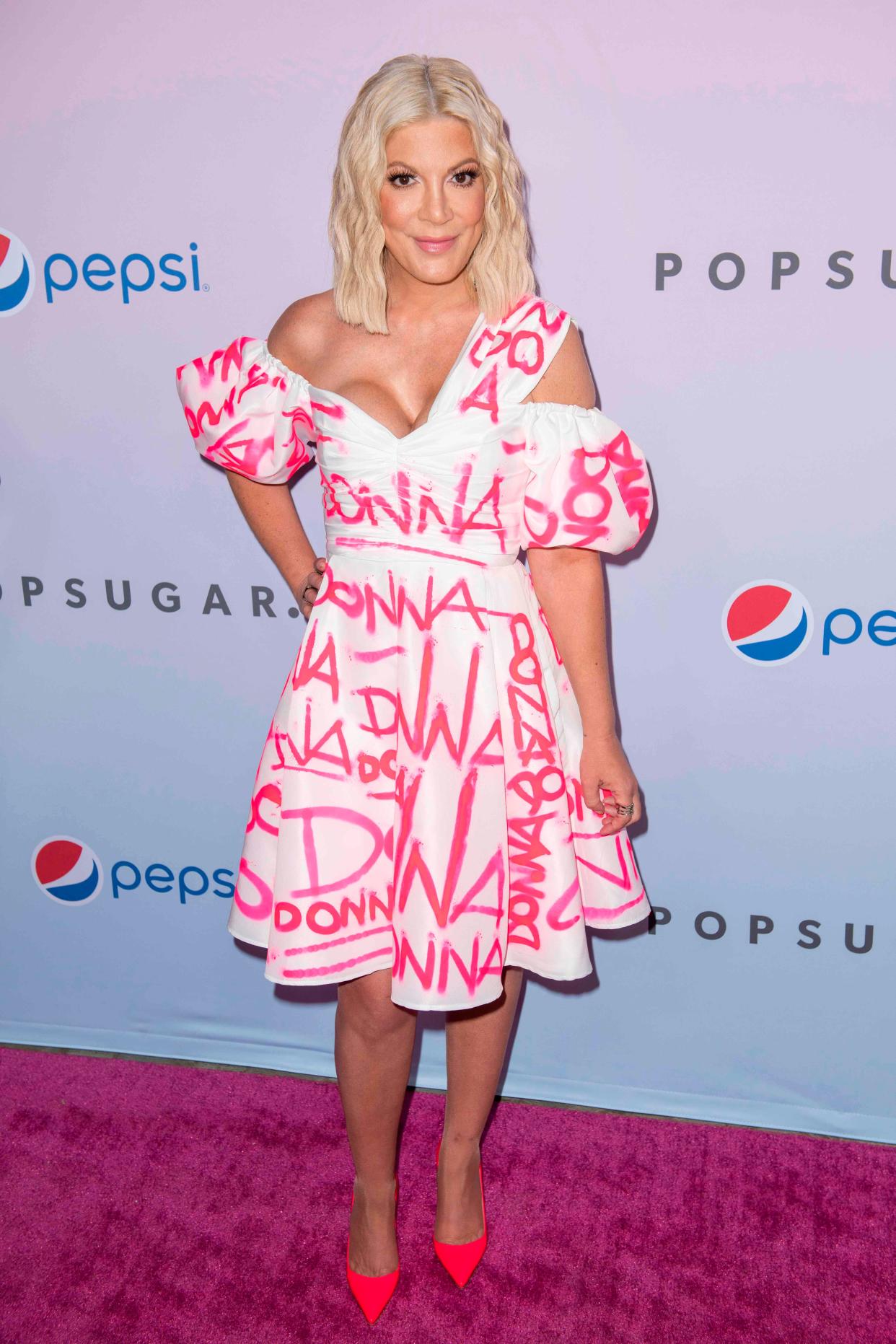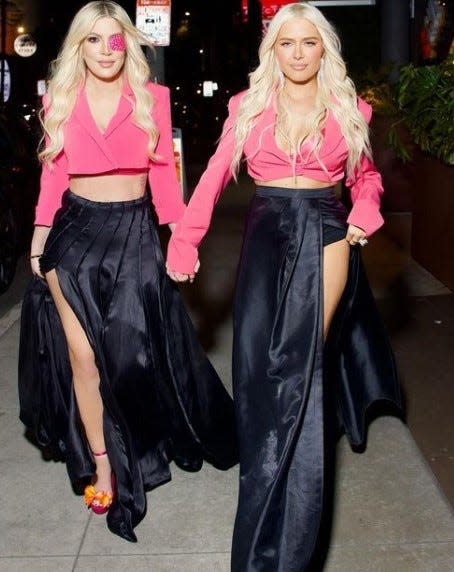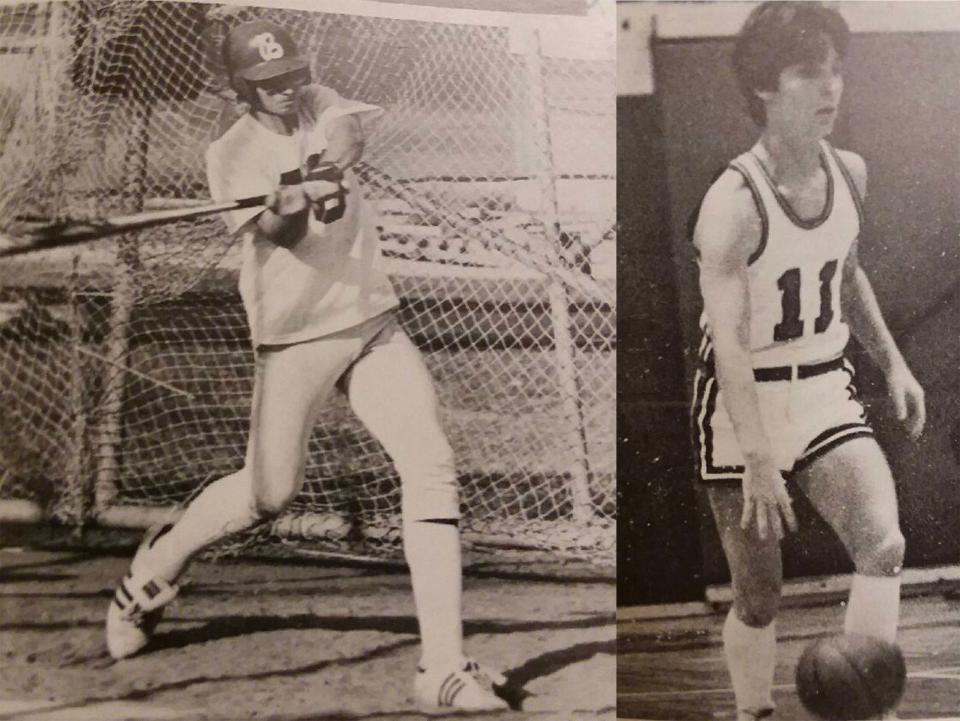'Eye' can't believe it: How celeb's self-inflicted infection a reminder about vision health

- Oops!Something went wrong.Please try again later.
- Oops!Something went wrong.Please try again later.
I’ve been a corrective lenses wearer since age 15 — and almost certainly could’ve benefited from having them prescribed earlier (more on that momentarily).
So count me among those who were flabbergasted by former “Beverly Hills 90210” star Tori Spelling’s revelation earlier this month that her ulcerated eye was caused by wearing her contact lenses 24/7 — including while sleeping — for perhaps up to three straight weeks.
In both public appearances and while taping her “90210MG” podcast (which she does with co-host and former "90210" co-star Jennie Garth), the 49-year-old actress had been sporting a pink eyepatch.
She explained to Garth what happened: "It's my fault. I did this to myself. So I have contacts, but I wear daily ones. And, at the end of the day, kids, whatever, I can make all the excuses I want. I don't take them out. I sleep in them. It's not healthy and you're supposed to change them.”
Spelling told Garth that, while she didn’t know exactly how long she’d gone without changing her lenses, she's "been known to go maybe 20 days" without removing them.
Garth’s response: “Oh my God!”
"I know, you guys, it's shaming," Spelling said. "I tell my eye doctor, I'm totally transparent."
With restaurants around the U.S., this celebrity chef comes to town for another mission
Spelling said she had a corneal ulcer in her left eye and this is what her doctor told her: "She said, 'You're lucky to get away with it, considering what you [did] to your eye for this long. And she said when our eyes are younger they can take things like this. When kids are in college and they sleep in them, it's fine.”
According to Cleveland Clinic, a corneal ulcer is "an open sore on your cornea [and] infection is the leading cause. Symptoms include a red, watery and bloodshot eye; severe eye pain and pus or other eye discharge." Depending on the cause of the corneal ulcer, the condition is usually treated with "eye drops containing antibiotics (for bacterial infections), antifungals (for fungal infections) and antivirals (for viral infections)."

Spelling described the ulcer as being like a "cut" or "divot" in her eyeball and that “it hurt so bad.” While her eye heals, she’s been prohibited from driving and figured she’d need to wear the eye patch for a week or two. She also said that once she was fully healed, she’d be switching from daily wear lenses — which the user is supposed to dispose of after a single use — to 30-day lenses.
I suppose Spelling deserves some kudos for owning her mistake. But removing two contact lenses takes fewer than 10 seconds. To not do so for weeks on end is the health and hygiene equivalent of not buckling your seatbelt because the task takes too long.
Memorable introduction to contact lenses
I first learned of the existence of contact lenses around age 6 or 7 when my dad and I went to an American Basketball Association game between the host Floridians (formerly Miami Floridians) and the visiting Pittsburgh Condors at the Miami Beach Convention Center.
This was sometime in either 1971 or 1972.
During the action a Condors player had a contact lens pop out. The lens likely was a hard one as soft contact lenses had just become available in 1971.
Genetic testing: How four generations of a family have battled multiple cancers
At the next stoppage of play, coaches and players from both teams, as well as the referees and some venue staffers, got on their hands and knees in search of the small piece of rigid plastic.
I can’t recall whether the wayward lens was ever located — but I can confirm the scene looked as ridiculous as it sounds.
Vision was rarely, if ever, checked
Back in those days, I went to my pediatrician only if I was sick. There were no yearly physicals or “wellness checkups.”
In fact, the only times I underwent cursory physicals was when it was required in order to be cleared for either sleepaway camp or to play interscholastic sports.
The vision check during these physicals was to simply read the eye chart posted on the wall. I have one memory at about age 11 or 12 of having trouble reading some lines on the chart — and begging my pediatrician’s nurse, Nancy (who had known me since I was born), not to say anything to the doctor.
Amazingly, I guess she kept our secret (shame on you, Nancy — but also thanks!) because there was no mention of it by my doctor.
Teachers never said anything either
By the time I reached junior high school, I was starting to have trouble reading the chalkboard when seated at the back of the classroom.
The solution? Why, sit closer to the chalkboard, of course.
I never thought anything was wrong with my eyesight, though. I simply thought everybody had trouble reading the chalkboard from far away.
How not a single teacher through my seventh-, eighth- and ninth-grade years ever notified my parents or mentioned to me that I should probably have my eyes checked still baffles me.
It wasn’t until I was 15 and completely failed the vision test for my restricted driver’s license (couldn’t read a single line on the eye chart ― but I did pass the written portion of the test!) that your extremely nearsighted columnist finally was directed to an optometrist.
A whole new world
As anyone who’s been tested and fitted for prescription lenses can attest, they immediately transform your world:
“Oh, that’s what colors really look like.”
“Hey, everything is totally in focus.”
And the truth, at least for me as a teen, was that until you’re shown there is a way to literally see the world more clearly, you simply don’t know any different.
While at first I didn’t wear my glasses at all times, they were always on my person.

And I wore them at all times while playing baseball and tennis. However, I wasn’t comfortable using them on a basketball court, primarily because they’d move around and sweat would drip on them. Eventually, I got tired of the same thing happening with my glasses on the baseball diamond and tennis courts; so within a year, I got fitted for contact lenses — and have been using both ever since.
Daily wear, extended wear, the kinds you can (allegedly!) sleep with — I’ve tried them all.
In my 20s and 30s sometimes I did fall asleep inadvertently while wearing them — almost always someplace other than my home — and upon awaking was so uncomfortable I needed to remove them immediately.
Evolution of my vision
As a teen my prescription was -3.00 in the strong (right) eye and -4.50 in the weak (left) one. Over the decades the prescription needed to be strengthened. For the past two decades, it’s stabilized at -4.50 in the strong eye and -6.00 in the weak eye.
When friends used to lament their ever-weakening vision as a sign of aging, I remember being thankful that I got to bypass that rite of passage.
Or so I thought.
You see, I was always able to read and see up close whether I was wearing my glasses/lenses or not.
Around a decade ago (my late 40s/early 50s), I began having trouble reading while wearing my lenses.
More: New CDC report shows teen girls facing unprecedented mental health challenges
I told my optometrist and she suggested we decrease the strength of the prescription.
Well, that didn’t help at all!
It just made my distance vision weaker.
What she SHOULD have suggested — and what I had to figure out on my own — was that when wearing my corrective lenses, to see up close and/or read I’d also need over-the-counter reading glasses.
(I now have a different optometrist.)
I’m still able to read while not wearing any distance correction lenses — but perhaps someday I’ll need magnifying readers for that too.
The older we get, the more we must pay attention to changes in our vision — and address them immediately.
Regardless of where you are in your vision journey, if you wear prescription eyeglasses and/or contact lenses, here are a few more tips from a lifelong myopia sufferer:
Always, always, always wash and fully dry your hands before handling your contact lenses.
Give yourself at least 30 to 45 minutes (or longer) after awakening before you insert your contact lenses. You don’t want your eyes to feel irritated by putting in your lenses too soon after sleep.
If you can afford it, spend the extra $100 or so for the Transitions eyeglass coating that turns your glasses into sunglasses when you’re outside.
Handle your eyeglasses with two hands to ensure that you don’t inadvertently cause them to lose their shape.
Clean your eyeglasses only with a smooth microfiber cloth.
Keep a spare pair of prescription eyeglasses and contact lenses in your glove compartment. You never know when you might need either or both.
This article originally appeared on Palm Beach Post: Tori Spelling slept for weeks in contact lenses and ulcerated her eye

